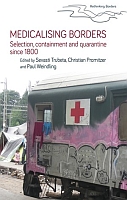Chapter 9 ‘Suspect’ screening
the limits of Britain’s medicalised borders, 1962–1981
| dc.contributor.author | Bivins, Roberta | |
| dc.date.accessioned | 2021-06-18T13:55:04Z | |
| dc.date.available | 2021-06-18T13:55:04Z | |
| dc.date.issued | 2021 | |
| dc.identifier.uri | https://library.oapen.org/handle/20.500.12657/49621 | |
| dc.description.abstract | Like their peers across western Europe, Australia and the Americas, large segments of the British public and a significant proportion of Britain’s medical establishment have enthusiastically promoted medical screening (and de facto medical selection) of would-be migrants since World War II. Moreover, from 1962, British law explicitly empowered medical inspection and the exclusion of migrants on health grounds at all three of Britain’s idiosyncratic ‘medical borders’: during entry clearance procedures in their countries of origin; at Britain’s ports and airports; and via public health surveillance in the British towns and cities that were the migrants’ destinations. However, Britain’s geographical and internal borders were largely unmedicalised in the twentieth century and remain comparatively free from specifically medical controls even today. I explore the role of the National Health Service – both as a national symbol and as a physical institution – in shaping and responding to this paradox. Given the intensity of popular suspicions of migrants’ bodies and their hygienic and reproductive practices, and the frequency with which medical claims mediated and bolstered anti-migrant rhetoric, why has medical ‘control’ itself proven politically elusive and persistently suspect? | en_US |
| dc.language | English | en_US |
| dc.relation.ispartofseries | Rethinking borders | en_US |
| dc.subject.classification | thema EDItEUR::P Mathematics and Science::PS Biology, life sciences::PSX Human biology | en_US |
| dc.subject.classification | thema EDItEUR::J Society and Social Sciences::JH Sociology and anthropology::JHM Anthropology | en_US |
| dc.subject.classification | thema EDItEUR::M Medicine and Nursing::MB Medicine: general issues::MBX History of medicine | en_US |
| dc.subject.classification | thema EDItEUR::J Society and Social Sciences::JH Sociology and anthropology::JHM Anthropology::JHMC Social and cultural anthropology | en_US |
| dc.subject.classification | thema EDItEUR::J Society and Social Sciences::JB Society and culture: general::JBF Social and ethical issues::JBFH Migration, immigration and emigration | en_US |
| dc.subject.classification | thema EDItEUR::5 Interest qualifiers::5P Relating to specific groups and cultures or social and cultural interests::5PB Relating to peoples: ethnic groups, indigenous peoples, cultures and other groupings of people::5PBC Relating to migrant groups / diaspora communities or peoples | en_US |
| dc.subject.other | medical borders; racialised migrants; health controls; medical inspection; United Kingdom; Commonwealth; migration; National Health Service; medical surveillance | en_US |
| dc.title | Chapter 9 ‘Suspect’ screening | en_US |
| dc.title.alternative | the limits of Britain’s medicalised borders, 1962–1981 | en_US |
| dc.type | chapter | |
| oapen.relation.isPublishedBy | 6110b9b4-ba84-42ad-a0d8-f8d877957cdd | en_US |
| oapen.relation.isPartOfBook | 7dee4ac4-417a-4be6-8abf-3788ba3074f0 | en_US |
| oapen.relation.isFundedBy | d859fbd3-d884-4090-a0ec-baf821c9abfd | en_US |
| oapen.collection | Wellcome | en_US |
| oapen.pages | 29 | en_US |
| oapen.place.publication | Manchester | en_US |
| oapen.grant.number | 104837/Z/14/Z |

